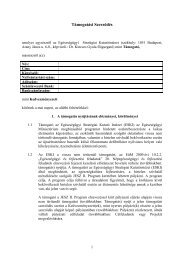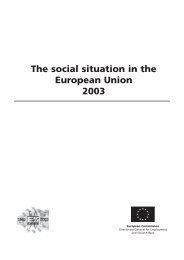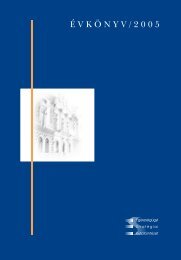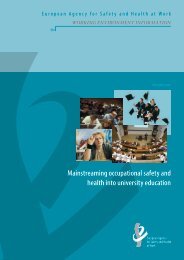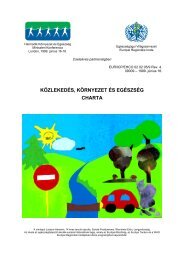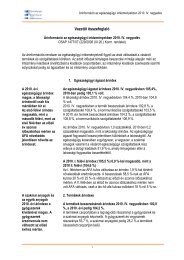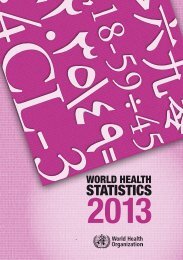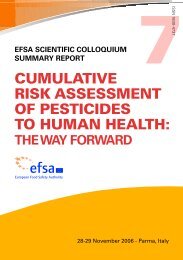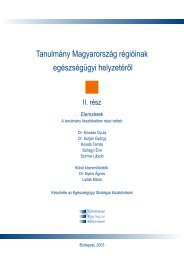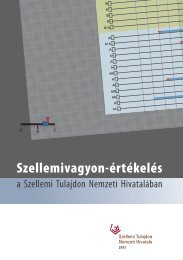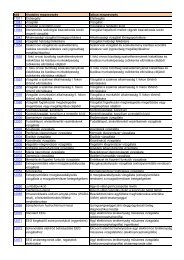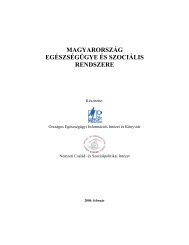WHO Technical Report Series, No. 981 - World Health Organization
WHO Technical Report Series, No. 981 - World Health Organization
WHO Technical Report Series, No. 981 - World Health Organization
Create successful ePaper yourself
Turn your PDF publications into a flip-book with our unique Google optimized e-Paper software.
<strong>WHO</strong> Expert Committee on Specifications for Pharmaceutical Preparations Forty-seventh report<br />
<strong>WHO</strong> <strong>Technical</strong> <strong>Report</strong> <strong>Series</strong>, <strong>No</strong>. <strong>981</strong>, 2013<br />
26<br />
responds to the fact that the problem of SSFFC medicines has continued to grow<br />
in complexity, scale and geographical extent.<br />
The project's long-term objective is to significantly improve the quantity,<br />
quality and analysis of data on the incidence of SSFFC medicines – through<br />
building on existing systems and by creation of a global surveillance and<br />
monitoring system – to provide stakeholders with a sound basis on which to<br />
build and collaborate on strategies for radically reducing the incidence of SSFFC<br />
medicines and protecting supply chains.<br />
Moreover, the increased quality of data and detailed information will<br />
enable more efficient information exchange between countries and facilitate<br />
regulatory action to protect patients and consumers.<br />
The project aims to create a sustainable surveillance and monitoring<br />
system for collecting, disseminating and analysing information on SSFFC<br />
medicines, based upon analysis of experience with existing systems such as the<br />
rapid alert system (RAS) in the <strong>WHO</strong> Western Pacific Region, and reflecting at<br />
least the requirements of the project participants, but ideally the requirements<br />
of all stakeholders. It will collect best practices for reporting of cases of SSFFC<br />
medicines, and will facilitate common understanding and unification of the<br />
minimum standards needed for individual case-reports. In addition it is intended<br />
to help national medicines regulatory authorities (NMRAs) to identify SSFFC<br />
medicines that have entered or that threaten to enter their country's supply<br />
chain. Data and case-reports relating to SSFFC medicines will be collected from<br />
NMRAs, to generate sound and reliable evidence of where incidence of such<br />
medicines is most serious. The aim is to promote sharing of information and<br />
expertise between NMRAs, in order to stimulate action (including alerts and<br />
regulatory action to protect patients and consumers), and closer collaboration, to<br />
minimize the negative impact of SSFFC medicines.<br />
The project is currently in the pilot phase testing a new information<br />
technology (IT) platform and reporting processes developed over the past two<br />
years. At present 10 countries are participating actively in the pilot study. Once<br />
the system is up and running other countries will be able to join.<br />
The Expert Committee valued the new project on market surveillance<br />
and noted the report.<br />
8.4 Proposal for revision of good trade and distribution practices<br />
The <strong>WHO</strong> guide on Good trade and distribution practices for pharmaceutical<br />
starting materials was published in 2003. In 2006, the International Pharmaceutical<br />
Excipients Council (IPEC) – an industry association comprising excipient<br />
manufacturers, excipient distributors and their pharmaceutical customers –<br />
published its GDP Guide for pharmaceutical excipients, which was fully aligned<br />
with the <strong>WHO</strong> document. Since the publication of these guidelines, a number of



